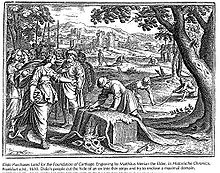Dido (mythology)



Dido (also Elissa or Elyssa ) was the founding legend of Carthage after a Phoenician princess.
myth
The historian Junianus Justinus calls the founding of Carthage in connection with "Elissa" (Dido among the Romans, Punic "'Išt"). Elissa is said to have been the Tyrian daughter of King Mutto . Because of her persecution by her brother Pygmalion , she came to the Gulf of Tunis via Cyprus . The Numidian king Iarbas promised her as much land as she could encompass with a cow skin. Dido then cut the cowhide into thin strips, put them together and was thus able to mark a large piece of land ( see also: Isoperimetric problem ). This coastal strip formed the Byrsa, the castle of the later Carthage, the nucleus of Carthage. After the founding of Carthage, Elissa sacrificed herself on a stake to guarantee the city's prosperity. According to another version, Iarbas wanted to force her into marriage, so she burned herself to death.
The name "'Išt" (Elissa) is attested several times in Punic onomastics , although its meaning "the active one" has not been clarified with certainty. In the Tyrian onomastics, however, the name "Pygmalion" is unknown. The fact that a woman led such a far-reaching expedition does not correspond to the circumstances at the time and is therefore not very credible. The existence of an "Elissa cult " is also controversial . The previous escape also has legendary features. Further details of the story are based on Greek folk etymology . All in all, the "Justinus source" is therefore to be assessed as not very reliable. There is no reliable evidence for the founding of Carthage.
In addition, the name of Dido is linked to Aeneas . However, this version does not appear until about 800 years after the founding of Carthage in Virgil's Aeneid , the founding myth of the Roman Empire . The relationship there is as follows: On the flight from Troy , Aeneas and his companions are driven by a storm to the coast of the newly founded Carthage, where Queen Dido welcomes him hospitably. At the instigation of Venus , the mother of Aeneas, who wants to protect her son in this way, and Juno , who wants to keep him away from the promised land of Italy, Dido falls madly in love with Aeneas. Despite an oath that she had once sworn never to get involved with a man again, she unites with Aeneas in a cave during a storm. But Jupiter sends the messenger of the gods Mercurius to remind Aeneas of his duties - so he leaves Carthage, which drives Dido to suicide: she stabs herself with the sword of Aeneas. But first she swears vengeance and thus creates the basis for the later conflict between Rome and Carthage.
According to older traditions, Dido had other reasons to commit suicide: Iarbas, who saw that Dido was building a successful city, now wanted to force it to marry him. Pressed by her own people, she was forced to commit suicide in order to be loyal to her late husband.
reception
Christopher Marlowe processed the legendary material for his drama Dido, Queen of Carthage .
There are about 90 operas -Vertonungen the substance of the unfortunate love of Dido to Aeneas, of which about 40 on the libretto Didone abbandonata of Pietro Metastasio . Mention should be made, for example, of the Metastasio setting by the German composer Johann Adolph Hasse as well as Dido and Aeneas by the English composer Henry Purcell and Les Troyens by Hector Berlioz . In the fifth part of the Sid Meier's Civilization computer game series , Carthage under Dido is one of the playable civilizations.
The Mount Dido in Antarctica is named after her.
literature
- Fritz Graf : Dido. In: The New Pauly (DNP). Volume 3, Metzler, Stuttgart 1997, ISBN 3-476-01473-8 , Sp. 543.
- Joachim Hamm: Infelix Dido. Metamorphoses of a love tragedy. In: Dorothea Klein, Lutz Käppel (Hrsg.): The discursive legacy of Europe. Antiquity and reception of antiquity (= cultural-historical contributions to the Middle Ages and early modern times. Volume 2). Lang, Frankfurt am Main 2008, pp. 1-24.
- Thomas Kailuweit: Dido - Didon - Didone. An annotated bibliography on the Dido myth in literature and music. Lang, Frankfurt am Main 2005, ISBN 3-631-52030-1 .
- Otto Meltzer : Dido . In: Wilhelm Heinrich Roscher (Hrsg.): Detailed lexicon of Greek and Roman mythology . Volume 1,1, Leipzig 1886, Sp. 1012-1018 ( digitized version ).
- F. Nolfo, Epigr. Bob. 45 Sp. (= Ps. Auson. 2 pp. 420 s. Peip.): La palinodia di Didone negli Epigrammata Bobiensia e la sua rappresentazione iconica , "Sileno" 41 / 1-2, 277-304;
- F. Nolfo, Su alcuni aspetti del 'movimento elegiaco' di un epigramma tardoantico: la Dido Bobiensis, “Vichiana” 55/2, 2018, 71-90;
- Erika Simon : Dido . In: Lexicon Iconographicum Mythologiae Classicae (LIMC). Volume VIII, Zurich / Munich 1997, pp. 559-562.
- Philipp Theisohn: Dido and Aineias. In: Maria Moog-Grünewald (Ed.): Mythenrezeption. The ancient mythology in literature, music and art from the beginnings to the present (= Der Neue Pauly . Supplements. Volume 5). Metzler, Stuttgart / Weimar 2008, ISBN 978-3-476-02032-1 , pp. 216–229.
- A. Ziosi, Didone regina di Cartagine di Christopher Marlowe. Metamorfosi virgiliane nel Cinquecento , 2015;
- A. Ziosi, Didone. La tragedia dell'abbandono. Variazioni sul mito (Virgilio, Ovidio, Boccaccio, Marlowe, Metastasio, Ungaretti, Brodskij) , 2017.
Web links
Individual evidence
- ↑ a b Werner Huss: History of the Carthaginians (Department 3, Part 8). Beck, Munich 1985, ISBN 3-406-30654-3 , pp. 41-42.
- ↑ Gerhard Fink: Who is who in ancient mythology. dtv non-fiction book, Munich 1993, ISBN 3-423-30362-X , p. 91.
- ↑ Dido, Queen of Carthage. In: Reclam's Opernlexikon. Philipp Reclam jun., 2001, p. 590 ( digital library , volume 52).
